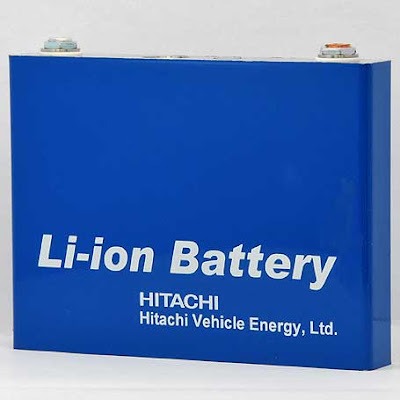
"GM is working closely with suppliers to optimize the cost of all the pack's components and hopes to hit the U.S. Advanced Battery Consortium target of $300/kWh by 2015."
This is the most important message for us from this first step among many to bring Electric cars on the road. It means affordability and it means mass market for EVs - this is what we are waiting for with our Lithium and REE plays.
Lithium Juniors are breaking out of consolidation stage with news from Magna and GM Volt hitting the wires."

"We have discussed Lithium and REE investment opportunity with the Big Picture investment approach in our Macro View on Micro Caps. Now we would like to make a model of EV Value chain and analyse the investment potential of its different parts."

It is getting crowded in Lithium battery sector, big names are piling in. There will be place for EnerDel and A123, but will they make money or margins will be razor thin in order to secure contracts? You will be choosing between concentrated players with limited technological and financing resources and Asian giants piling in where Lithium sector growth will be spread across all revenues. Our idea is to go where they will all come later - Lithium supply chain.
Tech-On:
Hitachi Develops Li-ion Battery Cell for PHEVs
Jan 13, 2010 15:51 Kouji Kariatsumari, Nikkei Electronics
The lithium-ion battery cell for plug-in hybrid electric vehicles. Its capacity is 25Ah.
Hitachi Vehicle Energy's lithium-ion battery cells
Hitachi Ltd and Hitachi Vehicle Energy Ltd developed a lithium-ion battery cell that has a high energy density and a high output density for plug-in hybrid electric vehicles (PHEVs).
The energy density and output density of the new battery cell are 120Wh/kg and 2,400W/kg (SOC: 50%), respectively. While the output density is equivalent to that of an existing battery cell that the companies are producing in volume for hybrid electric vehicles (HEVs), the energy density is about twice as high.
The new battery cell measures 146 x 110 x 30mm and weighs 0.75kg. Its average voltage is 3.6V. Though the companies did not disclose the details, the positive and negative electrodes contain oxide including a manganese substance and a carbon material, respectively. They have already made a test production line and plan to ship samples to automakers in the spring of 2010.
Hitachi Vehicle Energy has been developing battery cells mainly for HEVs. The company defines the cylindrical cell that it is now mass-producing as the second-generation product.
Also, it plans to produce 300,000 units of the third-generation product per month for General Motors Corp's mild hybrid vehicles and other vehicles in 2010. The third-generation product is a cylindrical cell that is 40mm in diameter and 92mm in length. Its current capacity, average voltage and output density are 4.4Ah, 3.6V and 3,000W/kg, respectively.
Furthermore, Hitachi Vehicle Energy has already developed the fourth-generation product, whose output density (4,500W/kg) is 1.5 times higher than that of the third-generation product and started shipping samples in the autumn of 2009. The fourth-generation product is an angular cell that has a high cooling performance. And its positive and negative electrodes are made by using a manganese substance and amorphous carbon."
Jan 13, 2010 15:51 Kouji Kariatsumari, Nikkei Electronics
The lithium-ion battery cell for plug-in hybrid electric vehicles. Its capacity is 25Ah.
Hitachi Vehicle Energy's lithium-ion battery cells
Hitachi Ltd and Hitachi Vehicle Energy Ltd developed a lithium-ion battery cell that has a high energy density and a high output density for plug-in hybrid electric vehicles (PHEVs).
The energy density and output density of the new battery cell are 120Wh/kg and 2,400W/kg (SOC: 50%), respectively. While the output density is equivalent to that of an existing battery cell that the companies are producing in volume for hybrid electric vehicles (HEVs), the energy density is about twice as high.
The new battery cell measures 146 x 110 x 30mm and weighs 0.75kg. Its average voltage is 3.6V. Though the companies did not disclose the details, the positive and negative electrodes contain oxide including a manganese substance and a carbon material, respectively. They have already made a test production line and plan to ship samples to automakers in the spring of 2010.
Hitachi Vehicle Energy has been developing battery cells mainly for HEVs. The company defines the cylindrical cell that it is now mass-producing as the second-generation product.
Also, it plans to produce 300,000 units of the third-generation product per month for General Motors Corp's mild hybrid vehicles and other vehicles in 2010. The third-generation product is a cylindrical cell that is 40mm in diameter and 92mm in length. Its current capacity, average voltage and output density are 4.4Ah, 3.6V and 3,000W/kg, respectively.
Furthermore, Hitachi Vehicle Energy has already developed the fourth-generation product, whose output density (4,500W/kg) is 1.5 times higher than that of the third-generation product and started shipping samples in the autumn of 2009. The fourth-generation product is an angular cell that has a high cooling performance. And its positive and negative electrodes are made by using a manganese substance and amorphous carbon."
1 comment:
I was unaware that Hitachi had developed a the battery for the Chevy Volt. I hear it is suppose to be one of the fastest electric cars made, and will be one of the most feature-filled also. I can't wait to see the algae technology become integrated into this design, as well as the rechargeable carbon fiber type.
Post a Comment